Roccat Kone EMP RGB Gaming Mouse Review
Pros
Cons
Rating
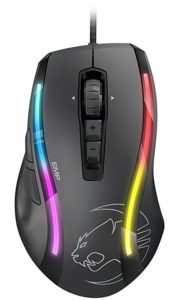
Introduction
Over the past few years, we’ve been through our fair share of gaming mice, including many of the RGB variety. Our Keyboard & Mouse Review Page is veritably littered with them, including reviews of such standouts as the Corsair M65 Pro RGB, the G502 Proteus Spectrum, and the Razer Deathadder Chroma, and more recently, the Logitech G403 Prodigy Wireless Gaming Mouse, which we consider the best mouse ever released. We even gave the Roccat Kova a trial run in our recent review of the pioneering Roccat Sova lapboard. Through it all, we’ve come away with the impression that there’s only so far we can push the boundaries of mouse design, it having been pretty well cast over the past 30 years or so.
So, what’s a mouse manufacturer to do? Polish their gems! And that’s exactly what Roccat has done with its popular Kone mouse, which has morphed from its original XTD form to the current Kone EMP we’re testing here. To the casual observer, these two mice look identical, and indeed, they utilize the exact same shape. But they in fact are not remotely the same. The scroll wheel has been smoothed over without losing its rubber grip, the DPI buttons have been made easier to hit, and the seldom-used front button has been removed. The internal changes are even more significant. Do they make an already-great mouse strong enough to defeat its best-selling foes? Read on to find out!
We’d like to extend a special thank you to Roccat for providing us with a review sample of the Roccat Kone EMP RGB Gaming Mouse.
Description and Features
Shown below you can see the Kone EMP in profile, sandwiched between the Logitech G502 Proteus Spectrum on the left and the Razer Deathadder Chroma on the right (which Razer still humbly markets as “The World’s Best Gaming Mouse,” despite the fact that it sells several newer, more expensive models). In any event, these are the two best wired mice we’ve ever tested, so we’re going to be using them as benchmarks in this review. In our opinion, peripheral reviews just aren’t all that helpful in a vacuum, doing little more than regurgitating a marketing department’s bullet points. We’ve read plenty such reviews over the years, but luckily we’re in position where we don’t have to write them!

Like its rival Razer (but unlike Logitech), Roccat has stuck to a consistent design motif for quite some time. This suggests the firm has identified a unique shape that happens to work really well for its users. From out point of view, the Kone is quite possibly the most ergonomic of PC mice, with its softly-flowing lines, graceful thumb and finger rests on either side, and large but unintrusive side-mounted buttons. That’s amazing when you realize this design first appeared back in 2012 on the Kone Pure. The lines are accentuated by the cool lightpipes Roccat introduced on the Kone XTD the same year, which was truly cutting edge at the time. Razer cribbed this basic concept in 2015 in its range-topping Mamba Tournament Edition, but went well beyond what Roccat did by offering multiple LEDs per pipe, rather than a single LED on either end.
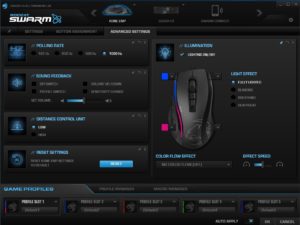
Honestly speaking, the first thing we did when we plugged in our Kone EMP sample was to see if this had changed, but alas, it has not. And this is where the “features” section of the Kone story starts to go off the rails just a bit. The Kone EMP is coming in at a pretty high price ($80), and yet it’s still using the same RGB effects its predecessor has featured for a number of years. The competition has moved on, and we’re surprised that now that the age of the RGB is truly upon us, Roccat didn’t take the obvious next step. The Kone EMP looks great in static images (and in static lighting mode), aided in part by the natural dithering of light projected by the LEDs on either end of the lightpipes. But it’s very disappointing when using any animation routine, as it simply cannot provide the rainbow wave effect that you get on other peripherals, including some of Roccat’s high-end keyboards, Razer’s high-end mice, and mousemats like the Razer Firefly and Corsair’s Polaris, which we recently reviewed. When set in motion, you realize you’re just seeing four blinking lights, which isn’t all that cool. We also noticed a glitch in the Swarm software, a screenshot of which is shown here. Specifically, the colors selected for the right side of the mouse (red and yellow in this instance) do not appear in the control panel, instead showing up as unselected. We bet Roccat will fix this in an upcoming release of the software (update: this was indeed fixed in the Swarm v1.91 update released on January 25, 2017, hours after we published this review – Roccat is serious about constant Swarm updates, so expect regular reminders to download them!).
Another surprising omission from the features list is the adjustable weight box featured in the older Kone XTD. To be honest, we think this is probably the right move, in part because the trend in mouse design today is to make mice as light as possible, rather than heavier. While it could have to do with a change in the types of games people are playing, we actually think it has more to do with the fact that high-refresh monitors are finally able to expose weaknesses in input devices that were previously hidden by boggy 60Hz monitors. When the mouse becomes the bottleneck in your 120fps gaming session, the extra weight kits you clung to dearly for so many years start to look less like an asset and more like a liability. Indeed, the Kone EMP weighed in at a solid 118g on our scale, versus 126g for the G502 sans extra weights, and an amazing 95g for the Razer Deathadder Chroma (Razer never jumped on the add-on weight train, and probably always knew lighter was better). The Kone’s weight is pretty impressive when you consider its above-average size: at 135mm long, 75mm wide, and 42mm high, it has an overall larger volume than the G502 or Deathadder. That makes it great for larger hands, but it may be just a bit too big for some users.
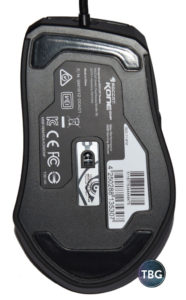
Ultimately, all the features we’ve highlighted so far are identical or just minor updates to the original Kone XTD. Where Roccat has moved on from the past in a big way is the sensor. The XTD debuted in 2012 with an 8,200dpi laser sensor, back when lasers were all the rage. As it turns out, lasers quickly fell out of favor for their negative impacts on accuracy, and manufacturers like Roccat, Corsair, and others began stumbling all over themselves to “downgrade” back to an optical sensor. In the case of the Kone XTD, Roccat debuted an updated XTD with a 6,200dpi optical sensor in 2014. Well, optical’s day has finally come, because it’s no longer a downgrade from lasers in any way. The Kone EMP uses a 12,000dpi optical sensor dubbed the “Owl-Eye” by Roccat, and derived from the ultra-high-end PixArt 3360 (referred to as the 3361 as utilized by Roccat here).
This sensor isn’t a Roccat exclusive, and is in fact the basis for the Pixart PMW3366 optical sensor used in the Logitech G502 (and G403 wireless). But they are not quite identical, because Roccat applies its own unique tuning to the sensor. Specifically, Roccat claims it has optimized the sensor’s functionality in the 200dpi to 2,000dpi range that most users actually utilize when gaming. We appreciate that despite using an ultra-high DPI sensor, Roccat is intent on going beyond that somewhat absurd testbed spec to provide a better overall experience for the humans that actually use their mice! By the way, if you take another look at the bottom of the Kone EMP as shown in the accompanying photo, you’ll notice the Kone’s large glide pads. We found that they provided a very stable base, limiting the chance for roll, while also keeping drag to a minimum and thus allowing the sensor to function unencumbered.
All right, now that we’ve covered the features of the Roccat EMP, let’s see how it performs in real-world use!
Performance
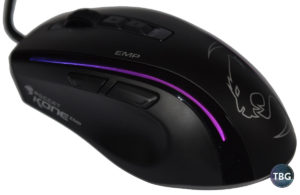 We started our performance evaluation in an application we use all day long, but have never utilized for mouse testing: Photoshop. Indeed, the precise movements required to edit our photos really highlighted the Kone’s low-speed accuracy. In comparison, the Logitech G502 felt heavy and sluggish, slowed down by drag from its suboptimal gliding surface, which we documented in our full review of the original G502 Proteus Core. The Razer Deathadder was light on its feet, but exhibited noticeable lag. Perhaps its lower-DPI sensor sensor has implications for this type of usage.
We started our performance evaluation in an application we use all day long, but have never utilized for mouse testing: Photoshop. Indeed, the precise movements required to edit our photos really highlighted the Kone’s low-speed accuracy. In comparison, the Logitech G502 felt heavy and sluggish, slowed down by drag from its suboptimal gliding surface, which we documented in our full review of the original G502 Proteus Core. The Razer Deathadder was light on its feet, but exhibited noticeable lag. Perhaps its lower-DPI sensor sensor has implications for this type of usage.
Mouse performance in part comes down to how a mouse “fits” each individual user, which for better or for worse means no mouse can be universal. As we discussed on the previous page, the design of the Kone EMP is basically perfect for larger hands. It avoids hard edges and jarring transitions between grippy and smooth surfaces, and has molded-in shelves for the thumb and fingers that really work, without getting in the way. In other words, you can actually grip this mouse as if it’s meant to fit in your hand.
But how would it do in gaming, where casual comfort isn’t as important as all-out responsiveness? Would the “Cadillac” feel end up hurting the Kone EMP? Starting off with the buttons, we found they had just the right amount of resistance and a satisfying click, and were accompanied by a meaty scroll wheel that provides excellent feedback without chatter or drag. Enhanced by a grippy rubber surface, this is by far the best scroll wheel we’ve ever come across. Unfortunately, we found another area of the Kone was pretty slick, namely its side grips. Unlike many other mice, including the Logitech and Razer benchmarks we used for this article, Roccat is employing a surprisingly-smooth gripping surface. Roccat markets this as a “Pro-Grip Surface” that maximizes durability. We have no doubt that it will last longer than rubber grips, which tend to break down over time, but in the short-run, we’re not sure it’s quite tacky enough, requiring a bit more effort to hold onto than its competitors.
The good news is that the Kone EMP excels in every other regard. Running through a few rounds of Battlefield 1 multi-player, the Kone put a lot of distance between itself and the Logitech G502 and the Razer Deathadder. The Kone felt ultra-responsive, playing lighter than its 118g would suggest thanks to its balanced and smooth gliding that provided practically no drag. The thumb shelf keeps your thumb off the mousing surface without getting in the way. And while the slick sides required a bit more tension to hold onto, they didn’t lead to the numbness in the fingertips that the textured nubs on the other two mice did. The Deathadder was particularly outclassed, despite being the top selling gaming mouse on the market. It really needs to be retired, but of course Razer will do no such thing as long as Razer fans keep snapping up this old warhorse. Its right side is uncomfortable to hold, failing to follow the contours of the human hand (and instead flaring out symmetrically with the left side in the interest of aesthetics), and it simply felt glitchy throughout our gaming session. Although its 10,000dpi optical sensor is just a step behind the Kone in terms of specs, it felt laggy and unresponsive, likely due to signaling problems inherent in the Deathadder’s old design. Seriously, folks, stop buying this thing! The G502 put up more of a fight, but while we like its general shape, all its hard edges and slightly mismatched rubber textures don’t allow the mouse to meld with the hand like the Kone EMP does.
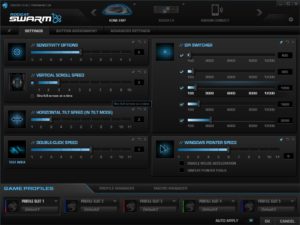
We should mention that while the Kone EMP feels great out of the box, there’s plenty of performance customization available in the Swarm application. This includes adjusting the responsiveness of clicking and scrolling, as well as changing the presets for the five DPI settings that can be accessed on the fly using the top-mounted DPI buttons. Mouse acceleration was enabled by default here, but we disabled it right away and suggest other users do as well. Not shown on this screen is the lift-off distance adjustment, which is found, oddly enough, on the color menu pictured on the previous page.
Conclusion
While we started off this review saying there wasn’t much that could be changed in mouse design, that doesn’t mean a few small tweaks here and there can’t add up to a superior product. Clearly, Roccat took its time studying what would make the Kone better than both its predecessor and its direct competition. Roccat has pushed the basic Kone concept to its pinnacle with the Kone EMP. It’s beautiful to look at, great to hold, impressively-light and yet somehow also heavy duty. And of course, with the new Owl-Eye sensor, it’s faster than you’ll ever need it to be. We’ve tested practically every gaming mouse on the market, and our two previous favorites, the Razer Deathadder Chroma and the Logitech G502 Proteus Spectrum, set the benchmark for wired mouse performance. That is true no longer. The Roccat Kone EMP RGB Gaming Mouse, available for pre-order at $79.99 as of our publication date, is the new benchmark for the best wired gaming mouse on the market.
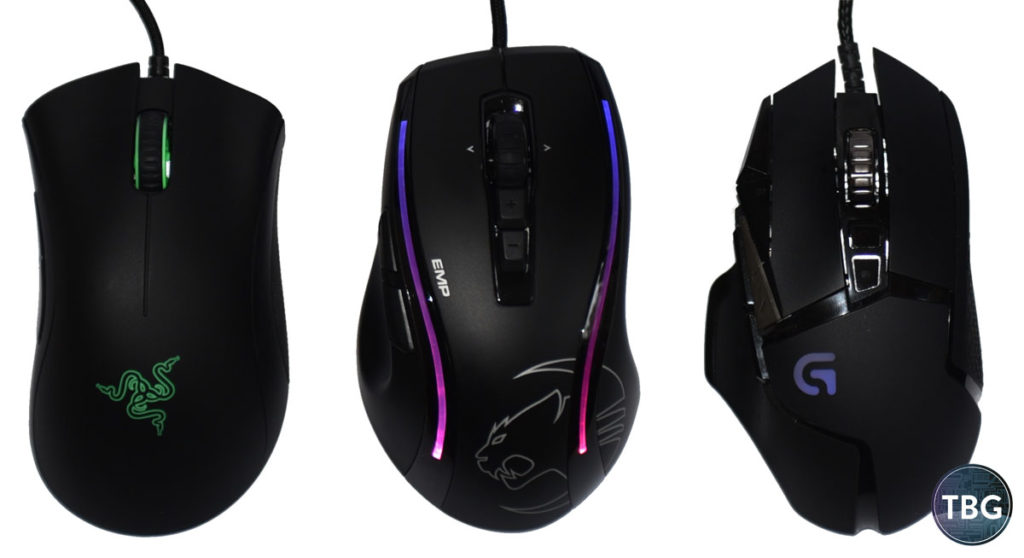
Alas, there’s just one thing standing in the way of Roccat’s total domination of the high-end gaming mouse market: the Logitech G403 Prodigy Wireless Gaming Mouse. This sublime wireless wonder hit the market at $100 in September 2016, when we reviewed it and named it the best mouse ever. It’s already dropped to $80 at retail, which is right where the Kone EMP debuts. As we discussed early on, mouse reviews conducted in a vacuum do a disservice to readers. Sure, absent the G403, the Kone EMP would easily rate 4.5 stars, if not a perfect 5 out of 5. It was able to handily dispatch its cheaper rivals in the wired mouse market, but there’s a “new reality on the ground.” The $80 Kone EMP must go head-to-head against the $80 G403 Wireless, and this is a fight it cannot win. Logitech changed the game, and assuming users are willing to deal with its weak lighting effects and need for regular charging, it’s still our top pick. We know there are traditionalists who will view a wireless mouse as inherently inferior in terms of lag and responsiveness. but again, we believe there’s a new reality at play here. When we picked up the G403 towards the end of our Kone testing session (long after tossing the rough-edged G502 and the stodgy Deathadder), we were reminded that the G403’s combination of a great sensor, lag-free signaling, and tetherless operation combine to provide freedom and responsiveness that no wired mouse, including the Kone, can beat.
To see all of our top picks in every peripheral category, don’t miss our Peripherals Buyer’s Guide, updated quarterly!

